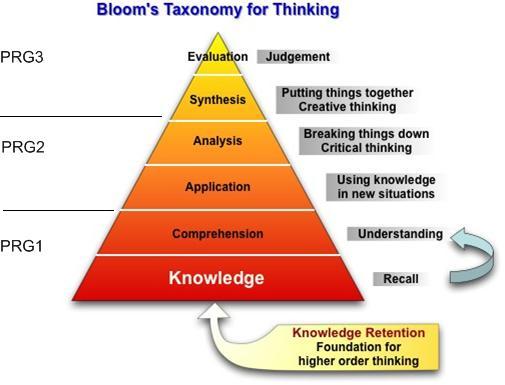 Wondering about Bloom and what he has to do with SAS programming. For any learner, he is someone to respect. For anyone wishing to learn more about the levels of the learning process, this is the master. Bloom classified cognitive, a big word for thinking skills, into 6 broad categories. In the learning process, you start with basic knowledge, then you apply it to situations and then you start to play with the knowledge by creating interesting solutions. Here is my take on mapping Bloom’s taxonomy onto the SAS programming language and the courses you take.
Wondering about Bloom and what he has to do with SAS programming. For any learner, he is someone to respect. For anyone wishing to learn more about the levels of the learning process, this is the master. Bloom classified cognitive, a big word for thinking skills, into 6 broad categories. In the learning process, you start with basic knowledge, then you apply it to situations and then you start to play with the knowledge by creating interesting solutions. Here is my take on mapping Bloom’s taxonomy onto the SAS programming language and the courses you take.

At the end of Programming 2, SAS learners have enough content to get that recognized by a standards body. In almost every class I teach, at least half of the class asks me how they can go about getting that standard. I’m excited about what we’ve managed to do. What we’ve been talking about for months is now a reality. With the help of my colleagues in Marketing and Education, I’ve put together a 1-day workshop to be held here in Canada chock full of content.
 In the morning we’ll share SAS content. In the afternoon you get to write a sample exam to see where you are. I tried it a few times and would highly recommend it. We also serve you breakfast & lunch & unlimited coffee. So that’s everything taken care of for you to just focus on learning & trying. I thought I’d draw you a pix. Do you like it and my take on Bloom? Are you curious about the workshop and finding out where you are in terms of SAS programming skills? If you’re in the neighborhood, come join me on October 11th.
In the morning we’ll share SAS content. In the afternoon you get to write a sample exam to see where you are. I tried it a few times and would highly recommend it. We also serve you breakfast & lunch & unlimited coffee. So that’s everything taken care of for you to just focus on learning & trying. I thought I’d draw you a pix. Do you like it and my take on Bloom? Are you curious about the workshop and finding out where you are in terms of SAS programming skills? If you’re in the neighborhood, come join me on October 11th.
I think Bloom would be happy to see his legacy taking such interesting shape. But I think he would be ecstatic if you would write to me. Bloom aside, for your own sake, if you’ve been thinking about certification & wondering where you stand, I would strongly recommend you consider taking this course. I’m here to help you so write to me; your questions and comments are what keep me going to help you further in your goals to master SAS.







6 Comments
This is a great approach. Most instructional designers use Bloom's Taxonomy when designing courses (at least ideally!). Unfortunately something gets lost in the translation and we as learners end up with something less than ideal.
A good ID will strive to follow Bloom and Gagne but sometimes the organization is to quick to releasre courses and ignoring good instructional design practice.
Cudos to you for making this a sound course!
I hope I get the opportunity to take it one day.
Sincerely,
Self-taught SAS user
Thanks Ray for your comment on using Bloom for instructional design. Hope to see you sometime in class.
I try to do the same thing with the topics I write about on my blog for SAS statistical programmers. On Mondays, I post introductory "getting started" examples that deal with syntax and SAS coding. On Wednesdays, I discuss statistical ideas and how to carry out the analysis in SAS. On Fridays, I discuss data analysis, which requires applying the sysntax and methodology to real data. This often involves making choices and judgements.
Another social science concept is the Johari window. Check out how the Johari window relates to these concepts!
Absolutely loved your take on the 4 quadrants... I'm finding my blog posts keep evolving depending on what I see or hear or get asked. did you start to write your mon, wed, fri blogs intuitively --and then later discovered that there is actually a pattern that other experts have talked about? Or did you already know what you were starting to do.. thanks for your note..
This sounds like a unique learning approach. I wish something like this was around when I was first learning SAS.
Yes, this is a great approach - one that I hated with a passion as a kid learning music, practicing the various note combinations again & again & again..for years before my teacher deemed me ready to perform in a creative concert. I didn't understand then that you always have some element of understanding before you can go on to create your own. Much like learning SAS syntax & then applying to real life problems.